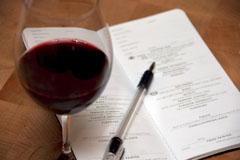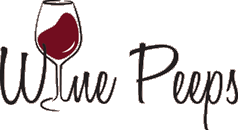Wine Reviews: What Kind Do You Prefer? (Part I)
By John ~ May 25th, 2011.
 Besides the obvious desire to find glowing reviews for wines that you like, do you prefer detailed notes that test the English language skills of the critic, only a quick and dirty points (or stars) rating, or something in between? Legendary Washington winemaker Bob Betz says, “Consumers have a 2-point system (not a 100-point), Yum or Yuck.†What about you?
Besides the obvious desire to find glowing reviews for wines that you like, do you prefer detailed notes that test the English language skills of the critic, only a quick and dirty points (or stars) rating, or something in between? Legendary Washington winemaker Bob Betz says, “Consumers have a 2-point system (not a 100-point), Yum or Yuck.†What about you?
If you already have a definite opinion on this subject, tell us in the comments. If you are not sure what kind of evaluation that you prefer, read the tasting notes and ratings below and then tell us in the comments which style of review that you like best. All of the tasting notes and ratings are for the same wine, which we will disclose in Part II of this post. Let the fun begin:
- Ripe in flavor, with a vivid array of black currant, blackberry, violet, black tea and black pepper aromas and flavors that zoom through to a long, expressive finish. Shows subtlety in the layers of complex flavor against a refined structure. Tannins are present but nicely contained. Best from 2010 through 2015.
- Deep, dark purple in color and very aromatic. Aromas of blackberry, black cherry, oak, spice, and a hint of cayenne pepper lead to flavors of blackberry, black currant, and chocolate. Full-bodied with good acidity, high tannins, and a very long finish. Well-balanced and extremely smooth.
- Scents of tobacco enhance the ripe, lush black fruits, which amply demonstrate the power of Washington grapes. The winemaking is polished, the barrel aging adds vanilla and smoke, and at this new, lower price, it’s a good value as well.
- The nose is less fruit forward … and has more of a spice component, particularly cigar box and black licorice. The fruit, particularly blackberry, is layered under the spice. The nose shows light coffee grounds as the wine opens up. This wine, at least initially, has a much bigger body … with black licorice on the taste and beautifully refined tannins that glide across the tongue. Overall, this is a much more tannin driven wine. Needs 2+ years to be at its best. 14.2% alcohol. 5,500 cases produced. After a couple hours of decanting, lots of blackberry and coffee grounds come through. This is a pretty big wine. The finish doesn’t have quite as much as I want which is its only detraction.
- 95 points.
- Quality: 4.5 stars (out of 5), QPR: 5 bangs for your buck (out of 5).
Now, what do you think? If you like just the rating and not all the verbiage, what rating scale do you prefer? 100 points, 20 points, 5 stars, etc? And do you like to see the QPR as well as the quality rating?
Filed under: Miscellaneous

 Wine Peeps is an independent wine blog dedicated to helping you get the most bang for your buck in wine. We do this through blind tastings of wine from around the world and calculations of
Wine Peeps is an independent wine blog dedicated to helping you get the most bang for your buck in wine. We do this through blind tastings of wine from around the world and calculations of 











I prefer a review like number 4. I like the wine profile to be broken down to sensory regions, or stages. I feel that this gives a taster (familiar with his/her own preferences and sensory receptors) the opportunity to find wines more to their liking. I.E. I am sensitive to tannins, therefore a too tannically structured wine is less enjoyable than an acid structured wine to me. All wine drinkers have a unique set of sensory receptors and enjoy wines of varying profiles that may greatly deviate from the Millers and Parkers of the world.
I also prefer the 5 star rating system paired with a sensory breakdown review.
I prefer reviews like number 4, but I also appreciate the quick quality breakdown as in number 6. I like *reading* the beautifully written descriptions, but they’re not nearly as useful.
I appreciate the descriptive but brief style of note number 2. I also like its sequencing (sight, smell, flavor/texture), which parallels what we do with a glass.
Rachael, Katie, & Gary,
Thanks for sharing your thoughts on wine reviews. I’ll incorporate your preferences in Part II of this post when I disclose the wine being reviewed.
For me, a mix of verbiage and score is best. Like Gary, I like the sight/smell /taste sequence. A mix of style 2 (brief) and 4 with the 100 point system gets my vote.
Thanks, Wayne. We appreciate your thoughts and will factor them into our summary in Post II.
The combination of score and descriptive explanation is most helpful to me in choosing wines. I like to read about the smell, taste, sight, other nuances that paint visual pictures that make you “taste” the wine before you drink it. Scores are good. They give clear perspective and logical measurements. Thank you for your insights, nice post.
Interesting post. What I notice in all descriptions is the absence of blind / unblind status of the taster. And further, how is the blinding done? Even experienced reviewers fall prey to thinking they are able to consciously limit bias and so they skip this crucial step. I have read reviewers justify their ‘unblind stance’ repeatedly, but remain strongly unconvinced. Can you imagine if your medications came with the disclaimer which said that the medications were proven to work based on studies where the scientists were aware of which patients got placebos?
In addition, the olfactory system is unable to distinguish more than 2-3 different flavors simultaneously, so listing 5 flavors (as opposed to mouthfeel descriptions) is silly. What also drives me crazy is when retail stores pick from many reviewers to find a ‘good score’ and then display that one only. This data mining makes their advertised ‘high’ scores invalid. Most importantly I think we should know who the reviewer is, and what the reviewer’s preferences are, which matters more than what the particular quality rating method might be used.
GourmetCoffeeGuy,
Thanks again for your thoughts and kind words.
Walt,
You make some good points. Thanks for commenting. While the question of blind/unblind status of these reviewers was beyond the scope of this post, a regular reader of Wine Peeps would know that we are big proponents of blind tastings.
Walt,
While it is true that tasters cannot distinguish more than 2-3 flavors simultaneously, one can take repeated sniffs and re-tastings to pick up multiple descriptors. So listing 5 flavors, I don’t think is “silly.”
Good point, Rand. Thanks for your comment.
I always condsider it valuable info when a “best from (year) through (year) is included. When reviewers say should evolve for “x” years and drink well over next “x” years who knows when review was written and who knows if they actually mean from year on bottle or from year of release.
Thanks, Joseph. You make a good point.
I like number 2 with a dash of number 4 thrown in. Number 2 is very like the way I experience wine.
Jim,
Thanks for weighing in with your thoughts. Good reasoning.
John, We have come a long ways from our days at Texas Tech and PKA.
Thanks for your Blog and all the information you and your family provide. If you get to Southwest Colorado (Lake City) come by and we can taste out our cellar.
We plan to take a trip to the Oregon wine country and coast starting June 8th.
Would have a list or suggestions of wines or vineyards we should not miss in Oregon.
Paul Hudgeons
P.O. Box 905
Lake City, Co 81235
970-944-2522
Paul,
Great to hear from you. Some of my Oregon favorites that immediately come to mind are Argyle, Lachini, Sineann, Owen Roe, Andrew Rich. There are many good ones.